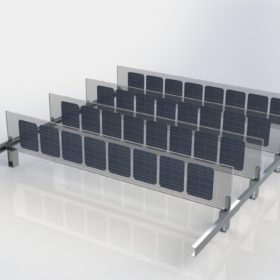Smarter E Products: Vertical PV system for green rooftops
Norwegian startup Over Easy Solar AS is launching a vertical PV system for rooftop applications at this year’s Smarter E in Munich, Germany.
The Hydrogen Stream: Fuel cell that uses iron instead of expensive platinum
In other news, Hydrofuel Canada developed hollow hybrid plasmonic nanocages to create an electrocatalyst for ammonia synthesis from nitrogen (N2) and water (H2O) and said green hydrogen could be separated from this ammonia and sold at about $1.50 per kilogram. Furthermore, Norway’s Aker Horizons and Statkraft are exploring green hydrogen and ammonia production opportunities in India and Brazil, targeting local steel and fertilizer industries.
Creative thinking for vertical east-west bifacial PV projects
A Finnish-Norwegian research group has assessed the global potential of vertical east-west bifacial PV (VBPV) projects and found that these installations may provide a low LCOE at Nordic latitudes, in Central Europe and subtropical desert areas. The researchers also found that residential and commercial VBPV systems are a grid-friendly solution for low-voltage networks when compared to monofacial arrays.
Monolithic fuel cell with power density of 5.6kW/L
An international research group has developed a solid oxide fuel cell that may be used in vehicles. The monolith device has an active cell area of around 18 cm2 and was built through common manufacturing processes. It was found to achieve a high power density of 5.6 kW/L, which the scientists said is comparable with that of the best performing fuel cells based on ceramic anodes.
Norway increases support for residential PV
Norway’s clean energy agency Enova will increase the maximum PV system size eligible for rebates from 15 to 20 kW and the maximum subsidy amount from 1,250 to 2,000 NOK ($226.7) per kW installed. In addition, new subsidies of up to 10,000 NOK will be introduced for energy management systems that are often installed alongside solar arrays.
New lithium-ion battery recycling plant in Norway
Canada-based Ly-Cycle has formed a joint venture with Norwegian-headquartered strategic partners Eco Stor and Morrow Batteries to build a new commercial lithium-ion battery recycling facility in southern Norway.
Solar the fastest growing European clean power source
The latest numbers released by EU data body Eurostat indicate renewables, including hydropower, contributed 37% of Europe’s gross electricity consumption in 2020, up from 34% a year earlier.
Norway deployed 65MW of solar in 2021
The provisional figure took the nation to a cumulative 215MW at the end of the year, according to new statistics provided by Norwegian solar industry organization the Solenergiklyngen.
Solar company’s Christmas party blamed for Omicron-variant Covid outbreak in Oslo
A news article published on Friday stated 13 cases had been confirmed and a senior physician said the working hypothesis was that at least half of the 120 people who attended the event had been infected. pv magazine has contacted Scatec for an update.
Imagine a nationwide energy system relying solely on distributed PV and V2G-equipped electric vehicles
Norwegian researchers have sought to assess the theoretical technical feasibility of a country-level energy system based exclusively on distributed solar, electric vehicles, and vehicle-to-grid technologies. They applied the model to sunny Spain and found that 3.45 billion m2 of PV systems would be necessary to build a 100% self-reliant energy system.










